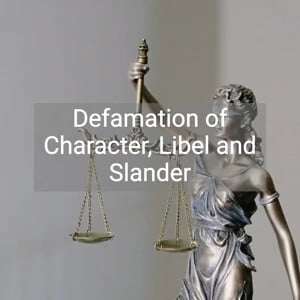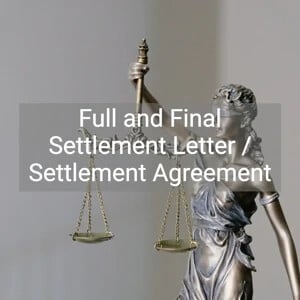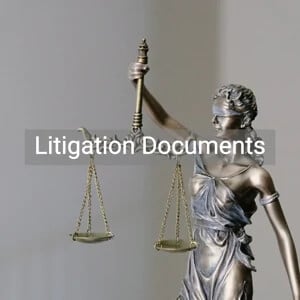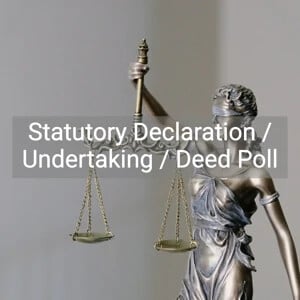Litigation Documents


1. Commencing and defending civil litigation can be very costly in terms of both money and time spent. Generally, the party who loses will be made to pay the other side’s legal costs, so it is best only to begin legal actions that you feel you have a good chance of winning. Prospective litigants will also have to familiarise themselves with the rules and legislation governing the Court’s processes. As always, it is best to try to resolve your legal problem outside of the courts if possible. If you are going to represent yourself, make sure you are familiar with the rules and legislation of the Court.
2. Some of the common types of civil action are:
3. It can take a long time to bring a civil case to trial and most cases do not result in a trial. Before a civil case is brought to trial, there may be interlocutory proceedings, held with the purpose of settling some procedural disputes, or dealing with urgent applications to preserve a party's rights.
4. Except in the case of appeals, judicial reviews, or applications, a person who commences a proceeding by writ shall be called a ‘Plaintiff’ and a person against whom a proceeding is commenced shall be called a ‘Defendant’.
5. There are three ways for Plaintiff to start a civil action:
6. Locus (Standing) of the Plaintiff
First thing is to establish standing or locus standi for the Plaintiff to sue – one needs to demonstrate to the court sufficient connection to and harm from the law or action challenged to support that Plaintiff's participation in the case. In some cases, this may not be obvious - for example, if you are to ask a neighbour to remove an illegal structure on the rooftop of your apartment building. Note that certain types of individuals, e.g. infants, mentally disabled persons, and the estate of a deceased person, can commence an action only by an appropriate representative. A company may either be represented by a solicitor or by one of its directors by filing an affidavit stating that he has been duly authorized by the board of directors and exhibiting either original or certified board’s resolution.
7. Identify the Defendant
Before issuing the writ, Plaintiff should ascertain the name of Defendant and his last known address. If Defendant is a company, Plaintiff should make a company search to obtain up-to-date information about its name and its registered office. If Defendant is a business (sole proprietorship or partnership), Plaintiff should conduct a business registration search at the Inland Revenue Department to ascertain the trade name and the principal place of business.
8. Statement of Claim
If Plaintiff is making a new claim against someone the most important thing to think about is what Plaintiff’s ‘statement of claim’ will contain. Plaintiff’s statement of claim contains Plaintiff’s allegations against Defendant by stating accurately the nature of and cause of the claim. It should, also state the relief or remedy sought in the proceeding (i.e. an explanation of the orders that the Plaintiff wants the Court to make in response). Where there is a question to be answered, the question shall be stated in the statement of claim. At the same time, Plaintiff also needs to pay attention to the procedural requirements of how Plaintiff will present Plaintiff’s statement of claim — either as a ‘writ’ or ‘originating motion’.
The decision about the appropriate way to commence a particular proceeding must be made by Plaintiff. Most proceedings start by filing a writ. The alternative, filing an ‘originating motion’, is used where there is no Defendant to the proceeding. A proceeding may also be commenced by filing an originating motion where it is unlikely that there will be any substantial dispute of fact.
It is Plaintiff’s responsibility to serve the Writ / Originating Motions and accompanying documents on Defendant. There are rules concerning the serving of documents to the Court and to the other parties involved in the Plaintiff’s case that must be adhered to. Any document required or permitted to be served in a proceeding may be served personally, but unless personal service is required by these rules or by order, it need not be served personally. Personal service of a document is effected by:
Other alternatives are by registered post, or by inserting the documents through the letterbox of the Defendant at his usual or last known address (or, in the case of a company, on the registered address). The document may be served by leaving the document at the proper address of the person on a day when the prothonotary's office is open, by posting the document, or by email where an email address for service has been provided. If the Plaintiff is serving on a solicitor, the document can be served by post, document exchange, fax, or by email where an email address for service has been provided. In an action for recovery of possession of land, Plaintiff must also post up a copy of the Writ at the entrance of the premises in question.
Please also note the following:
Plaintiff should file original documents in person at the Court Registry and serve the documents to the other parties (Plaintiff may have to pay a filing fee at the Accounts Office of the court upon filing the writ.)
Plaintiff will need to include in the Court filings an affidavit or affirmation that the writ of summons has been served on Defendant. In the affidavit or affirmation, Plaintiff has to state that he has personally served the sealed copy of the writ of summons on Defendant on a specific date (including the day of the week). If the service was by post or by insertion through the letterbox, the affidavit or affirmation has to state that the writ of summons has not been returned through the post (as the case may be) and that it will have come to the Defendant's knowledge within 7 days thereafter (timeline varies depending on the jurisdiction). If Plaintiff has an agent/representative to serve the writ, that agent/representative has to make such an affidavit or affirmation.
If one receives a writ of summons naming him/her as a Defendant, the Defendant is required to “acknowledge service of the writ of summons” (i.e. confirming that the document has been delivered to the Defendant) or file a “notice of appearance” (depending on the jurisdiction) and to state whether or not the Defendant wishes to defend the action brought against the Defendant by the Plaintiff, usually within 10 to 14 days of being served (depending on the jurisdiction). To avoid confusion, the time limit for filing will be recorded on the writ or originating motion.
If an “acknowledgment of service” / a “notice of appearance” is not filed the Plaintiff may ask the Court to grant the judgment or orders they have requested without any further notice to the Defendant. While any person duly authorised to act on a company’s behalf under the may file an appearance on its behalf, companies are usually represented by a solicitor.
Within approximately one month (exact date varies depending on the jurisdiction) after Defendant files a notice of appearance / an acknowledgment of service form indicating that he wishes to contest the civil action, Defendant should file and serve on Plaintiff his defence to the Plaintiff's claim (explaining why the Defendant is disputing the Plaintiff's claim) and a counterclaim against the Plaintiff (if any).
The defendant will need to think carefully about what the Defendant’s defence to the statement of claim will be, and if the Defendant’s defence will hold up to scrutiny in a court of law (i.e. how it is likely to be received in the Court). The defendant must specifically answer each and every allegation as set out in Plaintiff's statement of claim. It will be deemed that Defendant admits to any allegations that Defendant does not specifically deny in Defendant’s defence (the same applies to Plaintiff pleading to the counterclaim of Defendant.)
Apart from considering whether Defendant has a legal basis to defend the claim brought by Plaintiff, Defendant should also consider that if he or she ends up losing the case, Defendant will normally be ordered to pay costs (this generally means legal costs) to the Plaintiff. The defendant is not exempt from this even if he/she is a litigant in person (without appointing a lawyer). The costs are the expenses that the winning party has to spend on the preparation and hearing of the matter. These include the expenses for the lawyers representing the winning party (if any). The amount of the costs can be substantial, depending on the complexity of the case, the preparation work required, and the length of the hearing.
If Defendant files a defence (and counterclaim), Plaintiff may need to file a reply (and defence to counterclaim, if any). If Defendant files a counterclaim, Plaintiff will have to file and serve a defence to it within approximately one month after the service of the counterclaim if Plaintiff wishes to dispute it. The defendant can enter judgment in default of defence to the counterclaim if Plaintiff fails to do so within time. As far as the counterclaim is concerned, Plaintiff has become a Defendant.
If Defendant does not file an acknowledgment of service/notice of appearance or defence within the time allowed, Plaintiff can apply to the court for judgment in favour of the claim against Defendant. In such a case, a full trial is not required.
If the claim is related to a debt or liquidated damages (i.e. where the amount of the claim is fixed and ascertainable), such as an action on a dishonored cheque, the Plaintiff may enter judgment for the amount claimed and the relevant legal costs.
Interlocutory judgment will be entered instead of the Plaintiff claiming for unliquidated damages (i.e. where the amount of damages has to be assessed by the court), for example, for loss of profits or damages for injury to person or property. In such a case, the Plaintiff will have to appear in court so that a judge or a master can assess the number of damages he is entitled to.
If Defendant decides not to defend a case being brought against Defendant, and Plaintiff's claim against Defendant is for a liquidated amount, Defendant should indicate this decision on the acknowledgment of service form. Court judgment will then be entered against Defendant for the amount of Plaintiff's claim. If Defendant cannot afford to pay the amount of Plaintiff's claim, Defendant should make an application to the court for a stay of execution of the judgment (i.e. an application to delay the enforcement of the judgment against Defendant). Execution of the judgment will then be delayed. The defendant must, within two weeks, make an application to the court by issuing a summons, supported by an affidavit or an affirmation setting out the Defendant’s means. In the affidavit or affirmation, Defendant can state any offer which Defendant wishes to make for the payment of the amount claimed by Plaintiff. For example, Defendant can offer to pay the debt in installments.
If Defendant thinks that he owes Plaintiff some money (but not the amount claimed by Plaintiff), he/she may pay the amount he/she considers appropriate (together with interest) into court. Alternatively, if negotiations with a view to settlement are not successful, Defendant may pay the money he offered into court. On making any payment into court, Defendant must give notice to Plaintiff on the form named "Notice of payment into court".
If Plaintiff accepts the amount that Defendant has paid into the court, the claim will be settled at that amount and the Plaintiff can recover the legal costs from Defendant up to the time Plaintiff accepts the payment in court.
If Plaintiff does not accept the money paid into court by Defendant, Plaintiff may still continue with the civil action and the matter will be resolved by the court. The matter of payment into court by Defendant will not be disclosed to the judge at the trial. This is to avoid any bias or adverse inference being drawn against Defendant.
After the case is determined at a trial by the court, if Plaintiff succeeds in claiming more than the amount paid into court by Defendant, Plaintiff would be entitled to the legal costs for the whole trial. However, if the court awards to Plaintiff an amount less than or equal to the amount of Defendant's payment-in, the court may order Plaintiff to bear Defendant's costs from the time Plaintiff should have accepted payment-in to the end of the trial (the Defendant has to bear his own costs from the beginning of the case up to the time the Plaintiff should have accepted his payment-in.) There will be a set-off of the costs between Plaintiff and Defendant when the costs are assessed.
Parties should attempt to settle the matter outside of the courtroom to alleviate one party having to pay the legal bills of the other. The longer a matter is active the more legal costs will be building up.
The pleadings stage will then be complete. Next comes “discovery”, when each side must disclose to the other the documents he possesses that relate to the case. After disclosing the documents in the form of a list, both sides must allow the other side to inspect the actual documents.
Each party shall file and serve a timetabling questionnaire within 28 days after the pleadings stage is complete. You should try to agree with the other party (parties) on what directions to seek to prepare a case for trial.
The plaintiff must, within approximately 2 weeks (depending on the jurisdiction) after receiving the timetabling questionnaire from the other party (parties) or within 10-14 days upon expiry of the period for filing and serving a timetabling questionnaire, issue a case management summons for the court to give directions relating to the management of the case.
The court will fix a timetable for the steps to be taken and may fix a milestone date for a case management conference, pre-trial review, and/or the trial. You should comply with the directions as you may not be able to get extensions of time without sufficient grounds. In addition, you should attend court on the milestone dates, otherwise, your claim will be struck out.
After the Court has given directions for setting down, you should file with the Court an application to set a case down for trial and notification of setting down. In so doing, you have to pay a prescribed fee. Besides, a bundle of documents has to be lodged.
For cases in the Fixture List, both parties should attend before the Listing Officer on the date scheduled for date fixing. The Listing Officer will then list the case for trial in accordance with the directions given by the Master. After date fixing, the pre-trial procedure is then complete and parties should bear the trial date in mind and wait for the trial.
Once a case has been set down the title of the action and its action number will appear at the bottom of the Pending List if it is expected to be tried during the next succeeding month. Parties have to check the Pending List to see if their case has been listed on it.
Both parties should attend Court punctually on the trial date, bringing along relevant original documents and photocopies for the judge and the other party if necessary. Your witnesses should come with you. At the trial, the Court will hear the evidence of witnesses and the submissions of the parties. The Court may adjourn the case to another date if further information and/or evidence are needed. The Court may deliver judgment at the end of the trial or deliver / hand down the judgment at a later date.
If the parties are willing to settle, the Court will make the settlement an order of the Court. If you and the other party settle the case amicably before the trial, you may file a notice to discontinue the case or file a consent application setting out your agreement. You may also apply to the Court at the trial to have the terms of the settlement made an order of the Court.
If you are not satisfied with the decision of a Master, you may appeal against it to a Judge in chambers. You must do so by way of a notice within 14 days after the decision. If you are not satisfied with the decision of a Judge, you may apply to the Judge within 28 days for non-interlocutory judgments or orders, or within 14 days for interlocutory judgments or orders from the date of the decision for leave to appeal to the Appeal Court. If the Judge refuses to grant leave, you may apply within 14 days from the date of refusal to the Appeal Court for leave to appeal. The Appeal Court may grant leave on such terms as costs, security, etc. as it thinks fit.
If, after you have obtained a judgment, the judgment debtor fails to obey the order, you may apply to the Court for a Writ of Fieri Facias to enforce the judgment. The Bailiff will “levy execution” to recover the judgment debt by seizing goods and chattels of the judgment debtor to cover the money owed to you or to recover possession of the property for you.

13 Nov 2022
6 min read

22 Jan 2021
6 min read

15 Jan 2021
6 min read

1 Mar 2020
11 min read





Not the right document?
Don’t worry, we have thousands of documents for you to choose from: